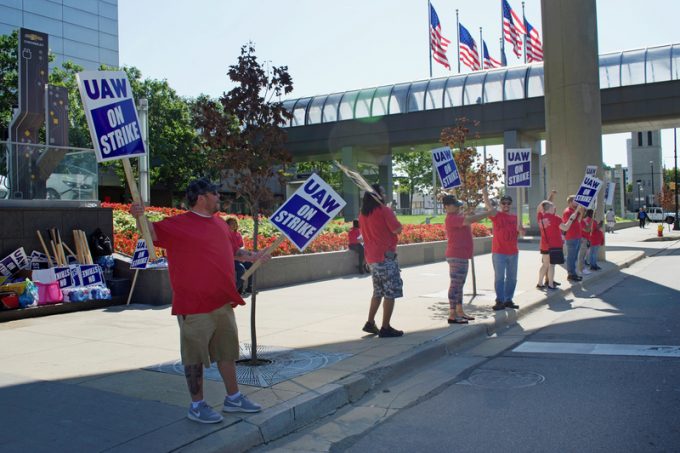
The strike called by the United Auto Workers (UAW) against the big three US carmakers went up a notch on Friday, as the union targeted spare parts centres serving General Motors and Stellantis.
So far there have been some hiccups in supply chains, but logistics providers are still waiting to see a major impact.
One week into contract negotiations, the UAW upped the ante with a second wave of strike action. In the first step, some 13,000 workers downed tools at three factories on 15 September to advance negotiations over their contract, which expired the day before.
The first three factories shut by work stoppages were a General Motors plant in Missouri, a Ford factory in Michigan and a plant in Ohio that turns out Jeeps for Stellantis.
The UAW had asked for pay increases of 40%, significantly more than the employers’ offer of 20% over four-and-a-half years. In addition, the union wanted to eliminate wage gaps separating newer and older employees and workers in certain component operations and those in assembly plants.
Union leaders had warned that lack of progress in the negotiations would trigger a second wave of strike action on 22 September and, saying no material progress had been made, called on 5,600 workers at the 38 parts centres to join the action.
The UAW did not expand the strike against Ford, saying negotiations there had shown some progress, although “serious issues” remained unresolved.
In a separate development Ford struck an agreement with the Unifor labour union in Canada to avoid a walkout.
UAW president Shan Fain said targeting parts distribution centres turned the union’s campaign into a nationwide strike. Disrupting the flow of auto parts also has a direct impact on consumers.
The union is pursuing a novel strategy in this strike. Historically, contract negotiations have been carried out with one automaker at a time. By going after production plants of all big three OEMs, the clash has targeted a broader front from the first day of work stoppages.
The initial repercussions on supply chains have been modest, though, noted Robert Gulyas, global VP automotive and industrial at Crane Worldwide Logistics.
“International suppliers didn’t have to do anything,” he said.
Much of the early fallout was due to lack of communication. On the first day of the strike many suppliers were not aware that a stoppage was already in progress and dispatched trucks to the targeted factories, he reported.
If the strike gathers momentum there will be a scramble for space in warehouses and yards to store parts that cannot be used, he warned, adding that those facilities would fill up quickly in the event of a fully fledged stoppage.
A second phase of a full strike would see cargo halted and suppliers idling their production facilities, while finished cars would pile up at factories and containers would pile up at ports, he said.
Tier-one auto suppliers were busy discussing scenarios in the run-up to the strike, looking at where to place parts and what spare capacity would be available, he explained. By most estimates, second- and third-tier suppliers would be most severely affected by a major strike. According to one observer, even a limited strike would have disastrous consequences, as their margins are razor-thin.
Mr Gulyas noted that the end of the strike would not bring immediate relief. He said: “We will see a huge need for emergency freight. Stopping and then re-starting production takes time. There will be shortages of commodities; there will be a need for charters.”
There is also the possibility of more strikes hitting the sector while the dispute continues. Last week some 190 unionised auto workers went on strike over pay at automotive supplier ZF Group in Alabama, which supplies Mercedes with front axles. Although the striking workers are UAW members, their action is unrelated to the clash between the union and the big three, according to ZF Group.